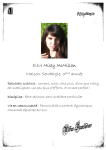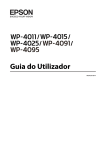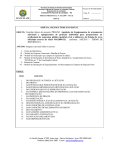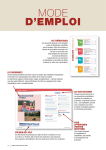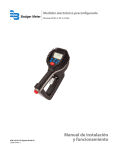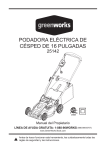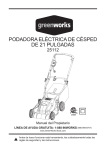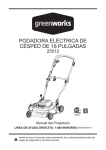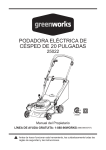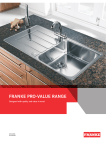Download Alexandria Moulding 00Q45-2R096 Installation Guide
Transcript
Installation and Finishing Guide What Tools do I Need to Install Moulding? Handy Tip: Here is the basic list of tools you will need to install moulding: • • • • • • • • • • • • • Miter Box, Miter Saw, or Compound Miter Saw Finishing Nails, Nail Set, and a Hammer or Brad Nailer Tape Measure Framing Square Protractor Pen and Paper Utility Knife Wood Filler and Glue Ladder Safety Glasses Hearing Protection Level Clamps Handy Tip Using a compound miter saw and a pneumatic nail gun will not only make the installation process easier, it will also speed up the time required for installation. If you don’t own or want to purchase these tools, they can be rented at The Home Depot Rental Center. Safety Tip Always wear eye, ear, and respiratory protection when doing any home improvement project. Remember safety first. How Much Moulding do I Need? To determine the amount of moulding needed for your project follow these steps: 1. 2. 3. 4. Draw a floor plan of your room. (Figure 1) Measure each wall and note it on your plan. Also note the placement and size of any doors, windows or openings in the room. It is also recommended that you identify each corner and the angle. (Figure 1.1) Add all of the wall lengths together to get the amount of moulding you need to purchase. Add 15% for cutting mistakes and waste. Measure Outside How do I Handle Long Walls? Sometimes it is necessary to span longer lengths than what is available in your local store, when this happens you will have to splice two lengths of moulding together. This type of joint is called a scarf/ splice joint. A scarf/splice joint will allow one piece to overlap the other section of moulding creating a longer piece of moulding. The scarf/splice joint creates a vertical seam in the finished installation. It is recommended that you place the scarf/splice joint over a wall stud for additional strength. Install the first piece of moulding against the wall with a 45 degree miter cut on end of the moulding opposite the corner. Do not nail within three feet of the scarf/splice joint at this time. Measure the next piece of moulding. The second cut will be the opposite of the moulding currently installed on the wall. Once the second cut has been made, install the moulding on the wall, placing a nail directly into the scarf/splice. How do I Install Moulding? Install moulding piece by piece working around the room, installing the longest pieces first. Avoid nailing within two to three inches of the end to avoid splitting. Some hardwood moulding will require pre-drilling before nailing. If you are hand nailing, be sure to use a nail set to sink the nail heads slightly below the face of the moulding. Handy Tip: If you are right handed, it is easier to install moulding counter-clockwise. If you are left handed, it is easier to install moulding clockwise. This way you can support the moulding with your un-favored hand and drive fasteners with your dominant hand. What Tools do I Need to Finish Moulding? Outside Mitre Inside Mitre Moulding Figure 1 To fix slight gaps in outside corners, fill the gaps with carpenters’ wood glue, and rub the gap with the side of a utility knife. This will crush the wood fibers to fill the gap. Figure1.1 2 Figure What Type of Moulding do I Need? For windows and doors you can use casing, for ceilings use crown, for floors use base, and for walls use chair rail or panel mould. You can choose from a wide variety of options to suit any style and every budget. For more tips on selecting or designing with moulding, pick up a copy of our free “Make an Impression with Moulding” or our free tear pad “How to Shop for Moulding”. • • • • • • Paint or Stain Drop Cloths Rags Wood Putty, Caulk and a Caulk Gun Brushes 220 Grit Sandpaper How do I Sand Moulding? Using a fine grit sanding sponge or 220 grit sandpaper mounted to a sanding block, always sand with the grain of the wood. Coarser grits of sandpaper or sanding against the grain of the wood will leave fine gouges and blemishes in the wood. A very light touch is required when sanding moulding. It is recommended that you sand between each coat of primer or paint. This light sanding will ensure a strong bond between the coats and give a smoother finish. What are the Basic Cuts for Moulding? Should I Prime My Moulding? The most basic cut for moulding is the miter. Most moulding is installed with miter joints that form a 90 degree angle. The first piece of moulding is cut with a 45 degree angle; the second piece of moulding is also cut with a 45 degree forming a tight 90 degree angle. In vertical applications (typically casing) the angles are cut on the face of the moulding. In horizontal applications (typically base, chair rail, crown) the angles are cut against the face of the moulding. (Figure 2) It is only necessary to prime solid pine or unprimed finger joint moulding. Most of the mouldings sold at The Home Depot come with a factory applied primer. If you are painting solid pine moulding or unprimed finger joint moulding, we recommend priming with a high quality primer. How do I Apply Wood Filler or Caulk? Wood filler or caulk is used to fill nail holes, repair scratches, dents, and uneven joints in miters. Always use a non-shrinking filler or caulk, follow the manufacturer’s directions to achieve the best results. For stainable mouldings, use wood filler that closely matches the wood color of your moulding. When Should I Paint or Stain My Moulding? Figure 2 What is Coping? A cope is an inside corner where one piece of the moulding is cut square and butts tight into the corner. The opposite side is first cut like an inside miter. Then using a coping saw remove the material from the moulding leaving the profile. (Figure 3) The cope joint will then fit over the square cut moulding on the wall. Coping can be a time consuming process but easily accommodates corners that are not 90 degrees and is very resistant to shrinkage. Staining or painting moulding before installation is always recommended. If you install your moulding and then finish it, protect the surrounding areas by using painters tape. Remember to remove the tape immediately after finishing to prevent the tape from damaging the wall or surrounding trim. Painting is recommended for all pre-primed moulding. It is also advisable to use two coats of paint for outstanding durability and appearance. Mouldings with a more pronounced wood grain or unprimed surfaces are better suited to staining or varnishing. Staining or varnishing enhances the natural beauty of the wood. Some types of wood moulding such as hemlock or solid pine can be stained to any color, while other types of wood moulding such as oak lend to darker stains. Finishing Recommendations Wood Species Stain Varnish Primed Fiberboard X Primed Finger Joint X Oak X X Pine X X Hemlock X X X Raw Finger Joint Figure 3 How do I End Moulding Without a Corner? If you need to end moulding without turning a corner or running into a wall, you will need to create a return. Cut the moulding to length finishing the piece with a miter angle. A return can be created by taking a scrap piece of moulding and cutting a miter on end of the scrap piece. Then cut straight down from the face of the moulding, ensuring the blade will meet the edge of the miter cut which forms a small triangular piece of moulding. Attach the piece with carpenters’ wood glue and secure the piece until the glue dries with masking tape. Paint Maple X X Fir X X For more information, visit www.homedepot.com/moulding Guía de Instalación y Acabado ¿Qué Herramientas Necesito para Instalar Molduras? Consejo Útil Esta es la lista básica de herramientas que necesitará para instalar molduras: • • • • • • • • Caja de ingletes, sierra para cortar ingletes o sierra para ingletes Clavos para acabado, Set de Clavos, y un martillo o un martillo neumático Brad Cinta métrica Escuadra Transportador Pluma y Papel • • • • • Cuchillo para uso general Relleno para de madera, masilla y pegamento Escalera Gafas de seguridad Protección para los Oídos Nivel Pinzas Consejo Útil Usando una sierra para ingletes y una pistola de clavos neumática no sólo hará el proceso de instalación más fácil, sino que también acelerará el tiempo necesario para la instalación. Si no posee, ni quiere comprar estas herramientas, se pueden alquilar en el Centro de Alquiler de Home Depot Center. Advertencia de Seguridad Use siempre protección para los ojos, oídos y respiración al hacer cualquier proyecto de mejoras para el hogar. Recuerde la seguridad primero. ¿Cuánta Moldura Necesito? Para determinar la cantidad de piezas de molduras que necesita para su proyecto siga estos pasos: 1. 2. 3. 4. Dibuje un plano de su habitación. (Figura 1) Mida cada pared y tome nota en su plan. También tenga en cuenta la ubicación y el tamaño de todas las puertas, ventanas o aberturas en la habitación. También se recomienda que identifique cada esquina y su ángulo. (Figura 1.1) Añada todas las longitudes de la pared para obtener la cantidad de piezas de fundición que usted necesita comprar. Añada 15% para errores y los residuos. Measure Outside ¿Cómo Manejo Paredes Largas? A veces es necesario abarcar tramos más largos de lo que está disponible en su tienda local, cuando esto le suceda tendrá que realizar una junta en dos molduras. Este tipo de articulación se denomina scarf/splice joint. Una scarf/splice joint permitirá que una sola pieza se solape con la otra moldura creando una pieza más larga de moldura. El scarf/splice joint crea una costura vertical en la instalación terminada. Se recomienda que coloque el scarf/splice joint sobre un montante de pared para fuerza adicional. Instale la primera moldura contra la pared con un inglete de 45 grados en el extremo del corte en el lado opuesto a la esquina. No clave dentro de los tres pies del scarf/splice joint en este momento. Mida la siguiente pieza de moldura. El segundo corte será el opuesto de la moldura actualmente instalada en la pared. Una vez que el segundo corte se ha hecho, instale la moldura en la pared, colocar un clavo directamente en el scarf/splice joint. ¿Cómo Puedo Instalar Molduras? Instale las molduras pieza por pieza trabajando alrededor de el cuarto, la instalación de las piezas más larga primeras. Evite clavar un plazo de dos a tres pulgadas del extremo para evitar rajaduras. Algunas piezas de fundición de madera requerirá la perforación previa antes de clavar. Si usted esta clavando a mano, asegúrese de usar un juego de clavos para hundir las cabezas del clavo ligeramente por debajo de la cara de la moldura. Consejo Útil Si usted es diestro, es más fácil de instalar piezas de fundición a la izquierda. Si usted es zurdo, es más fácil para instalar molduras desde el lado derecho. De esta manera usted puede apoyar la moldura con la mano sin favorecidas e impulsar los sujetadores con su mano dominante. Outside Mitre ¿Qué Herramientas Necesito para Terminar las Molduras? Inside Mitre • • • • • • Moulding Figura 1 Para solucionar las deficiencias leves en las esquinas exteriores, llenar los vacíos con pegamento de madera de carpintería, y frote la diferencia con el lado de un cuchillo. Esto hará que las fibras quebradas de madera llenen la brecha. Figure 1.1 2 Figura ¿Qué Tipo de Moldura Necesito? Para las ventanas y las puertas se puede utilizar Casing, para techos uso de Crown, para pisos use Base, y para las paredes use Chair Rail o Panel Mould. Puede elegir entre una amplia variedad de opciones para cualquier estilo y presupuesto. Para obtener más consejos sobre la selección o el diseño con piezas de fundición, recoger una copia de nuestro libro gratis “Make and Impression with Moulding” o la pagina “Como Comprar Molduras”. ¿Cuáles Son los Cortes Básicos para Molduras? El corte más básico para molduras es el inglete. La mayoría de las molduras se instalan con ingletes que forman un ángulo de 90 grados. La primera pieza de la moldura se corta con un ángulo de 45 grados, la segunda pieza de la moldura también se corta con un grado de 45 que forman un ángulo de 90 grados al unirse. En aplicaciones verticales (normalmente el Casing) los ángulos son cortados en la cara de la moldura. En aplicaciones horizontales (por lo general el Base, Chair Rail, y Crown) los ángulos se cortan contra la cara de la moldura. (Figura 2) La pintura o laca Paños Harapos Masilla para madera, masilla y una pistola de masilla Pinceles Papel de Lija 220 ¿Cómo Puedo Lijar la Moldura? Usando una esponja de lija de grano o lija de grano 220 montado en un bloque de lijar, siempre con el grano de arena de la madera. Lija de grano más grueso o lijar en contra de la veta de la madera dejará estrías finas y manchas en la madera. Un toque muy ligero se requiere cuando la moldura se esta lijado. Se recomienda que la arena entre cada capa de primer o pintura. Este lijado liviano asegurara una unión fuerte entre las capas y le dará un acabado más fino. ¿Debería de Pintar con Primer Mi Moldura? Sólo es necesario pintar con primer el pino macizo Primed Finger Joint. La mayoría de las molduras que se venden en The Home Depot vienen con un Primer aplicado de fábrica. Si usted está pintando molduras de pino macizo o primado Finger Joint, le recomendamos cebado con una imprimación de alta calidad. ¿Cómo Puedo Aplicar Relleno para Madera o Masilla? Madera o masilla de relleno se utiliza para rellenar los agujeros de los clavos, la reparación de arañazos, abolladuras, y las articulaciones desiguales en ingletes. Siempre use un relleno sin encogimiento o masilla, siga las instrucciones del fabricante para obtener los mejores resultados. Para molduras tingibles, use relleno de madera que más se ajuste al color de la madera de su moldura. ¿Cuándo Debo Pintar o Teñir Mi Moldura? Figura 2 ¿Qué es el Afrontamiento? Un frente es una esquina interior en donde se corta un trozo de la moldura cuadrada y queda justamente apretada en la esquina. El lado opuesto es el primer corte como un inglete interior. Luego, utiliza una sierra para eliminar el material de la moldura dejando su perfil. (Figura 3) La junta del afrontamiento se adaptará al corte cuadrado de la moldura en la pared. El afrontamiento puede ser un proceso que consume tiempo, pero se adapta fácilmente a las esquinas que no son de 90 grados y es muy resistente a la contracción. Siempre se recomienda teñir o pintar la moldura antes de la instalación. Si instala la moldura y luego le da la terminación, proteja las áreas circundantes usando cinta de pintores. Recuerde retirar la cinta inmediatamente después del acabado para evitar que la cinta dañe la pared o sus alrededores. Pintar es recomendable para todos las molduras Pre-Primed. También es recomendable utilizar dos capas de pintura para la durabilidad y la apariencia. Molduras de madera con granos más pronunciados o superficies sin prima se adaptan mejor a las lacas o barnices. Laca o barniz realza la belleza natural de la madera. Algunos tipos de madera, como la cicuta o pino macizo se pueden teñir a cualquier color, mientras que otros tipos de moldeado de madera como el roble prestan a teñir mas oscuros. Recomendaciones para el Acabado Especie de Madera Laca Barniz Fibra de madera imprimadas X Finger joint imprimadas X Roble X X Pino X X ¿Cómo Puedo Terminar Una Moldura Sin Esquina? Cicuta X X Si usted necesita hacer una terminación a una moldura sin esquina o que no termine en una pared, usted tendrá que crear un retorno. Corta la moldura a la medida para terminar la pieza con un ángulo de inglete. El retorno se puede crear tomando un pequeño trozo de la moldura y cortar un inglete a la pieza de sobra. Luego corte hacia abajo de la faz de la moldura, asegurando que la hoja se reunirá con el borde del corte de inglete, lo cual forma una pequeña pieza triangular de moldura. Fije la pieza con prensas para madera de carpintería y asegure que el pegamento en la pieza se seque, manteniendo las piezas juntas con masking tape. Finger joint común Figura 3 Pintura X Arce X X Abeto X X Para obtener más información, visite www.homedepot.com/moulding How to Shop for Moulding Step 3 – Find Your Moulding on the Aisle Step 1 – Measure Your Room • • • • Draw a floor plan of your room. (Figure 1) Measure each wall and note the measurements on your plan. It is recommended to note the placement and size of any doors, windows, or openings in the room. Also identify the angle of each corner. (Figure 1.1) Add all of the wall lengths together to get the total amount of moulding you need to purchase. Add 15% for cutting mistakes and waste. Measure Outside Ceiling Moulding Contains: Crown, Bed Mould, and Cove Mould Crown moulding is used as a transition where the wall meets the ceiling. Crown moulding can be combined with other moulding to create a “build-up”, a decorative moulding look. Bed mould is also used where the wall meets the ceiling similar to crown only usually smaller in size. Cove mould can be used in many applications such as an inside corner where two walls meet or where walls meet ceilings. Outside Mitre Inside Mitre Moulding Wall & Trim Figure 2 Figure 1.1 Figure 1 Contains: Base Cap, Base Shoe, Chair Rail, Ply Cap, Inside Corner, Outside Corner, and Panel Mould Handy Tip These mouldings are used to enhance the look of traditional mouldings or cover small imperfections in rooms. Base shoe is used to cover the transition between flooring materials and base moulding, base cap is used to enhance square base moulding around walls or staircases. Chair rail is used to add detail or divide a room horizontally. Ply cap is used to cover the top of wainscot for finished appearance. Inside and outside corners are used to cover imperfections where other materials meet or protect the wall from damage. Panel moulds are used to add interest to walls by creating faux boxes on the wall. Here is the basic list of tools you will need to install moulding: • • • • • • Miter Box, Miter Saw, or Compound Miter Saw Finishing Nails, Nail Set, and a Hammer or Brad Nailer Tape Measure Framing Square Protractor Pen and Paper • • • • • • • Utility Knife Wood Filler and Glue Ladder Safety Glasses Hearing Protection Level Clamps General Purpose Moulding Contains: Hand Rail, Lattice, Quarter Round, Full Round, Screen Mould, Shingle Mould, Window Stool, Door Stop, and Square Mould Step 2 – Determine What Type of Wood You Want These mouldings are used for a variety of purposes. Window stool is used at the bottom of windows to complete the finished look of the trim. Door stops are used to cover small gaps around doors and to keep the door from swinging in the wrong direction. Full round is often used as closet pole. Primed Finger Joint Color: Various shades of white with a pale yellow substrate Grain: Lightweight with a straight grain and uniform texture Application: Very easy to work, cuts and accepts adhesives and nails with ease. Accepts paint without the need for a primer coat. Door Shop Solid Pine Contains: Pre-Mitered Door Sets, Interior Jambs, Exterior Jambs, and Brick Mould Sets Color: White to pale yellow, sometimes with a reddish tint Pre-mitered door sets are ready to install without the need for cutting, they are available in traditional or no-miter designs. One set will cover one side of a door. Interior and exterior jambs can be used to replace worn or damaged door frames. Brick mould sets are ready to install without the need for cutting. One set will cover the exterior side of a door Grain: Lightweight with a straight grain and uniform texture Application: Very easy to work, cuts and accepts adhesives and nails with ease. Accepts stains and varnish well but would need a primer coat if painted. Can be stained or varnished to look like many other species of wood. Primed Fiberboard Step 4 – Only Cut What You Need Using the measurement plan you brought from home, cut your moulding to the rough length you need. Remember to add 15% to the measurements for miter corners and possible cutting mistakes. For detailed instructions on how to draw a room plan, see our free installation and finishing guide found on the moulding aisle. Color: Various shades of white with a light to medium brown substrate Grain: No grain Application: Primed fiberboard is free of natural defects and accepts paint easily with out the need for a primer coat. Not suitable in exterior applications or high moisture areas. Oak Color: Coral to a deep red Grain: Very heavy grain with a slightly coarse texture Quick Tips Box Application: Fairly easy to work, nails must be pre-drilled to ease installation. Accepts stains and varnish easily, the heavy grain compliments medium to dark stains for a classical look. Want to avoid tricky miter cuts? Step 3 – Find Your Moulding on the Aisle Check out the selection of mitered corner blocks in the Decorative moulding section Need to quickly replace door casing? Floor Moulding Check out the numerous styles of pre-mitered door casing sets in the Door Shop section. You can find a pre-mitered set to match or enhance any décor. Contains: Base Need to purchase a large quantity of crown, casing, or base moulding? Base moulding is typically installed where the floor meets the wall. It comes in various sizes and species to compliment any décor. Check out the great selection of propacks. A great value for that large job. Some casing profiles are available in pre-cut 7’ lengths and in pre-cut 7’ propacks, perfect for installing around doors. Make sure there is a UPC/barcode label on your cut piece of moulding, it will save you time at the cash register. Door & Window Moulding Contains: Casing, Brick Mould, and Back Band Casing is used for both functional and decorative trims on interior and exterior doors and windows. Brick mould is used typically used around exterior doors and windows. Back band is used as an accent around the outside edge of interior door and window trim to create a bolder look. Safety Tips • If possible, have someone assist you in holding your moulding while using the cutting cart. • If you remove a safety cable, please replace them. This will help moulding from falling out of the rack and possibly striking you or another customer. • Be careful when lifting heavy mouldings or propacks, if it is too heavy for you to lift on your own, ask a Home Depot associate for help. For more information visit www.homedepot.com/moulding Cómo Comprar Molduras Paso 3 – Encuentra Tu Moldura en el Pasillo Paso 1 – Mida su habitación • • • • Dibuje un plano de su habitación. (Figura 1) Mida cada pared y anote las medidas en su plano. Se recomienda tener en cuenta la ubicación y el tamaño de todas las puertas, ventanas o aberturas de la habitación. También determine el ángulo de cada esquina. (Figura 1.1) Sumar todas las longitudes de las paredes para obtener la cantidad total de piezas de fundición que usted necesita comprar. Añada 15% para los errores de corte y los residuos. Measure Outside Moldura de Techo Contiene: Crown, Bed Mould, y Cove Mould Moldura de crown se utiliza como una transición donde la pared se une al techo. Moldura de crown se pueden combinar con otras molduras, para crear un "buildt up," una mirada de moldura decorativa. Bed Mould también se utiliza done la pared se encuentra con el techo similar a el crown pero por lo general de menor tamaño. Cove Mould se puede utilizar en muchas aplicaciones como la esquina interior donde dos paredes se unen o donde las paredes se unen al techo. Outside Mitre Inside Mitre Moulding Paredes y Trim Figure 2 Figura 1.1 Figura 1 Contiene: Base Cap, Base Shoe, Chair Rail, Ply Caps, Angulo Interno, Angulo Externo, y Panel Mould Consejo Útil Estas molduras se utilizan para mejorar el aspecto de molduras tradicionales o cubrir pequeñas imperfecciones en las habitaciones. Base Show se utiliza para cubrir la transición entre los materiales del suelo y la moldura de la base, Base Cap se utiliza para mejorar la moldura cuadrada alrededor de las paredes o escaleras. Chair Rail se utiliza para añadir detalles o dividir una habitación en posición horizontal. Ply Cap se utiliza para cubrir la parte superior del zócalo para darle una apariencia de acabado. Esquinas internas y externas se utilizan para cubrir imperfecciones donde otros materiales se unen o para proteger la pared de los daños. Panel Mould se utilizan para agregar interés a las paredes mediante la creación de cajas de imitación en la pared. Esta es la lista básica de herramientas que necesitará para instalar las moldu• • • • • Caja de ingletes, sierra para cortar ingletes o sierra de ingletes Clavos para acabados, Set de clavos, y un martillo o un martillo neumático Brad Cinta métrica Escuadra Transportador • • • • • • • • Pluma y Papel Cuchillo para uso general Relleno para madera y pegamento Escalera Gafas de seguridad Protección para los Oídos Nivel Pinzas Moldura de Uso General Paso 2 – Determinar Qué Tipo de Madera Usted Desea Contiene: Hand Rail, Lattice, Ronda de Cuartos, Ronda Completa, Screen Mould, Molde de Teja, Repisa de Ventana, Para Puerta, y Molde Cuadrado Moldura con Uniones Listo para Pintar (Primed Finger Joint) Estas molduras se utilizan para una variedad de propósitos. Repisa de Ventana se utiliza en la parte inferior de las ventanas para completar el aspecto acabado de la guarnición. En la Puerta se utilizan para cubrir las lagunas pequeñas alrededor de puertas y mantener el vaivén de la puerta en dirección correcta. Ronda Completa se usa generalmente como poste para armario. Color: Distintas tonalidades de blanco con un sustrato de color amarillo pálido Grano: Peso liviano con una fibra recta y uniforme textura Aplicación: Muy fácil de trabajar, cortes y acepta adhesivos y clavos con facilidad. with ease. Accepts paint without the need for a primer coat. Acepta pintura sin la necesidad de una capa de primer. Pino Macizo Tienda de Puertas Color: Blanco a amarillo pálido, a veces con un tinte rojizo Contiene: Set de Puertas Pre-Cortadas, Jambs de Interior, Jambs de Exterior, y Brick Mould Sets Grano: Peso liviano con una fibra recta y uniforme textura Set de revestimiento de Puertas Pre-Cortadas están listos para ser instalados sin la necesidad de cortar, están disponibles en diseños tradicionales o sin inglete. Un conjunto abarcará un lado de una puerta. Jambas de interior y exterior se puede utilizar para reemplazar marcos de puerta desgastados o dañados. Brick Mould Sets están listos para ser instalados sin la necesidad de corte. Un conjunto cubrirá el lado exterior de una puerta. Aplicación: Muy fácil de trabajar, cortes y acepta adhesivos y las uñas con facilidad. Acepta las lacas y barnices bien, pero necesitaría una capa de primer si se pintan. Puede ser teñido o barnizado para parecerse a otras especies de madera. Moldura de Fibra Lista para Pintar (Primed Fiberboard) Color: Distintas tonalidades de blanco con un leve a mediano sustrato marrón Paso 4 – Por Ultimo, Sólo Corte lo que Usted Necesita Usando el plan de medida que se traen del hogar, corte la moldura a la longitud en bruto que necesita. Recuerde que debe añadir 15% de las medidas para los ángulos de inglete y posibles errores de corte. Para obtener instrucciones detalladas sobre cómo dibujar un plano de la habitación, ver nuestra guía de instalación gratis y el acabado se encuentra en el pasillo de molduras. Grano: Sin grano Aplicación: Moldura de fibra lista para pintar (Primed fiberboard) está libre de defectos naturales y acepta pintura fácilmente sin la necesidad de una capa de primer. No es adecuado para aplicaciones exteriores o zonas de alta humedad. Roble Color: Coral a un rojo profundo Sugerencias Rápidas Grano: Grano muy difícil, con una textura ligeramente gruesa ¿Quieres evitar cortes de inglete complicados? Aplicación: Bastante fácil de trabajar, los clavos deben ser pre-perforados para facilitar la instalación. Acepta fácilmente las lacas y barnices, el grano pesado complementa teñidos medianos a oscuros para una mirada clásica. Visite la selección de los bloques de esquina per-cortados en la sección de molduras decorativas Paso 3 – Encuentra Tu Moldura en el Pasillo ¿Necesita sustituir rápidamente revestimiento de la puerta? Visite los numerosos estilos de Set de revestimiento de Puertas Pre-Cortadas en la Tienda. Usted puede encontrar conjuntos pre-cortados de igual diseño o para mejorar cualquier decoración. Moldura para Piso ¿Necesita comprar una gran cantidad de crown, casing o moldura de base? Contiene: Base Descubra la gran selección de propacks. Un gran valor para ese trabajo de gran tamaño. Moldura de base se suele instalar donde el piso y la pared se unen. Viene en varios tamaños y especies para complementar cualquier decoración. Algunos perfiles de casing están disponibles pre-cortadas a 7 'y en propacks de longitudes pre-cortadas a 7', ideal para la instalación alrededor de las puertas. Asegúrese de que haya un código de UPC en su pieza cortada de moldura, que le ahorrará tiempo en la caja registradora. Consejos de seguridad Moldura para Puertas y Ventanas • Si es posible, consiga que alguien le ayude con el corte de su moldura, mientras use el carro de corte. • Si quita un cable de seguridad, favor de volverlas a poner. Esto ayudará a que la moldura no se caiga de la parrilla y posiblemente le de a usted o a otro cliente. • Tenga cuidado al levantar molduras o pro-packs pesados, si es demasiado pesado para usted, hable con un asociado de Home Depot para obtener ayuda. Contiene: Casing, Brick Mould, y la banda Back Band Casing es utilizado para trabajos de función o decorativos en las puertas y ventanas interiores y exteriores. Brick Mould es generalmente utilizado alrededor de puertas y ventanas exteriores. Back band se utiliza como un acento en todo el borde exterior del interior de la puerta y ventana para crear un look más audaz. Para obtener más información, visite www.homedepot.com/moulding
This document in other languages
- español: Finished Elegance 07713-96192C





